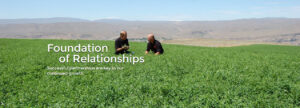
There’s no denying that agriculture changes the natural landscape and may affect wildlife habitat. However, some crops are actually beneficial to wildlife. Alfalfa is one of those crops that provide a favorable habitat for a wide variety of animal species, both above and below ground. In fact, many species prefer alfalfa over natural habitats because it provides nesting cover, harbors abundant insects, and is a nutritious feed source. Ten percent of the animals that utilize alfalfa use it for breeding and reproduction, 24% make use of the alfalfa canopy as cover, and 57% use it as a feed source. Wildlife may be frequent, moderate, or occasional users of the crop itself, the margins of the fields, or the plowed or seeded fields during harvest or stand cultivation, or irrigation. Some species use alfalfa only at specific times of field management, crop growth, or stage of wildlife.
Because alfalfa is a perennial, the field provides a relatively stable and relatively undisturbed environment where plant growth occurs throughout the year. The high feeding value of alfalfa is beneficial to many species of herbivores, including insects, rodents, and grazing animals such as deer, elk, and antelope. Alfalfa also provides cover that allows many species to feed, sleep, nest, or hide from predators. The ground beneath an alfalfa field is also a valuable ecosystem for earth worms, insects, and other organisms. Gophers and other rodents frequently settle under alfalfa fields.
The food chain often begins and ends in an alfalfa field. Hundreds of species of insects inhabit alfalfa. Many animals including bats, songbirds, swallows, waterfowl and migratory birds rely on the insect population in alfalfa fields for feed. Deer, elk, antelope, gophers, mice, and rabbits eat the alfalfa. In turn, hawks, eagles, migratory birds, and other predatory mammals such as coyotes and cougars hunt for birds and rodents that inhabit alfalfa fields. Ultimately, scavengers such as coyotes and vultures eat the dead animals and complete the food chain.
The importance of irrigation in alfalfa fields to wildlife cannot be overlooked. When summertime temperatures soar, irrigated alfalfa fields are often a welcome respite for overheated and thirsty animals. Water from irrigation also flushes rodents and insects to the surface, making them more available for raptors, birds, and snakes. In addition to the dense alfalfa canopy, irrigation creates a humid microclimate that is favorable for insects and bird eggs.
No doubt, alfalfa farming is an important economic enterprise. The significance of alfalfa to wildlife is also well documented and many farmers appreciate the wildlife on their farms and ranches.
To revceive this blog from Anderson Hay directly in you email, subscribe above on the right.
Reference
Putnam, D., M. Russelle, S. Orloff, J. Kuhn, L. Fitzhugh, L. Godfrey, A. Kiess, and R. Long. 2001. Alfalfa, Wildlife and the Environment. The Importance and Benefits of Alfalfa in the 21st Century. California Alfalfa and Forage Association, Novato, CA.


